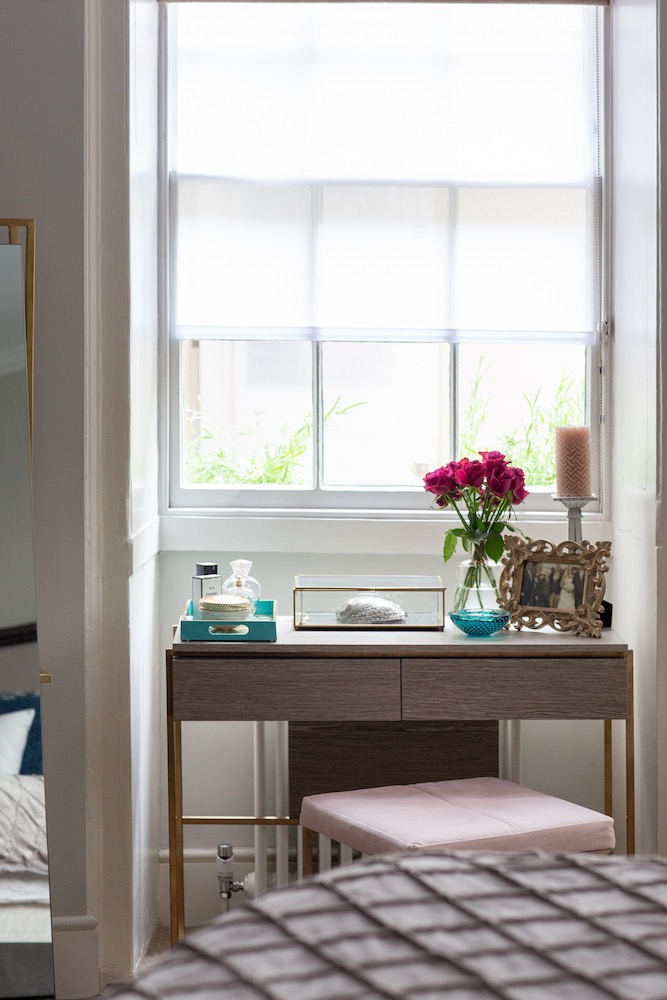Hello and welcome back to part 2 of this window treatment blog series.
Today we’ll build upon what we learned in part 1, where we discussed the importance of assessing a treatment’s function. We also discussed the various different window types, with a few of their pros and cons. I’ll consider these and apply them to a few window shapes, to show you how you can implement these tips and tricks in your own home.
I’ll begin by considering windows with tricky dimensions or shapes.
ARCHED WINDOWS
Depending on how much light filtering you want, there are several ways to approach these.
For more light, leave the actual archway of the window untouched. This will allow a lovely bright, sunny feel in the room, looking glorious in hallways, living, and dining rooms. Then you can treat the rectangular part of the window, again, how you would a normal, rectangular window.
In this case, you can choose any of the aforementioned treatments. If the window is recessed however, (leaving no wall space on either side of the window), use thinner fabrics that still allow you to access the window if you need to (for example if it’s a French door, or if you want to be able to open and close it frequently).
If you want to cover the arched part of the window, you can do this using blinds or shutters to treat the whole window. Remember, you can use a combination of shutters or sheers and curtains, or blinds and curtains – or just one or the other of any of these.
SMALL WINDOWS
Small windows require smaller window treatments. Use any window treatment, but with curtains, ensure that they hang just below the sill to give the appearance that they are bigger.
WIDE, SHORT WINDOWS
For these, you have several options. Firstly, you could go for floor length curtains, hung from a high-up curtain pole. This is a good option since windows of this shape are typically very drafty, so insulation is important here. This will give the illusion of windows being bigger and longer. Just make sure the poles extend out far enough, so that you have space for the fabric to gather.
If there is any awkward space between the top of the window and wall, you could place shelving or framed photos to create a lovely decorative feature. This type of window isn’t always bad! Alternatively, if the window is high up, place furniture below it to seem more proportionate to the rest of the room’s dimensions.
If the room these types of windows are in is a bit warmer, you could use sheers, either all over the windows or just for the bottom part of the window. This will maximise light that might otherwise be restricted, given the window size.
The next couple of points concern windows at awkward angles.
SKYLIGHTS
I’d recommend shutters and blinds for these types of windows, as they’re the only way you can go really, since curtains obviously won’t hang correctly. The best types of shutters and shades then are motorised ones (for skylights on hard-to-reach ceilings), roman ones (for an added bit of style), and/or blackout ones for bedrooms.
For kitchen/dining rooms or areas that generally don’t need any privacy, consider leaving them bare. This will introduce a huge amount of natural lighting into the space, which as we all know is never a bad thing!
DORMER WINDOWS
Dormer windows offer a few more possibilities. You could stick to just having blinds or shades if you’re tight on space or don’t mind a little bit of light leaking in.
You could have curtain poles on hinges, attached to the surrounding walls (see below) to maximise light in the space, which can then be turned inwards to conceal light when needed. Use these curtains in addition to blinds directly above the windows, if you have space and require more light coverage.
Alternatively you could hang these above the window, with or without a pole holding back the rest of the curtain. You’ll want a pole if you’re tight on space, and need things to be flusher to the wall. If your space is bigger, then you can do without.
The final window types are challenging due to their inherently architecturally large nature.
BAY OR BOW WINDOWS
These are a real standout feature within a room. Therefore, the treatment you choose is incredibly noticeable if done right, or wrong. The easiest way to dress this type of window is using blinds, since you can treat these window types as standalone windows.
Alternatively, you might consider blinds or shutters. You might want to add drapery on top of this if this is a particularly cold or ‘echoey’ room, but do feel free to keep things simple and minimalist if you’d prefer.
To install curtains here, you’ll need a curved rod from one side of the window to the other. You can either use two pairs of curtains for drapery between each window, or just one pair of two curtains that extend between the left and right hand side of the bay window edges. For a more traditional look, consider pelmets and valances to add even more texture.
FRENCH DOORS/WINDOWS
These are similarly challenging to bay windows, since they’re architecturally bold. With these you also need to consider the door swing, and how it’ll impact your choice of window treatment. There’s a couple of choices here:
You could either attach small poles above the glass of the door frame, perhaps hanging shutters, blinds, or a sheer fabric, for a more traditional look. This will also be better if you’re tight on space. On the other hand you could go for a simple pair of curtains – just make sure the pole for these has enough room at the end that it doesn’t block the door from opening fully, allowing room for gathering at the sides.
I really hope this blog helped you decide which treatments to use according to your window shape. If you’d like more help on how to decide which window treatment would work best for your home (as well as which fabrics and finishes to use), get in touch with us here. Enjoy the rest of October, and stay tuned for next month’s blog on How to reclaim your home after divorce or separation.











